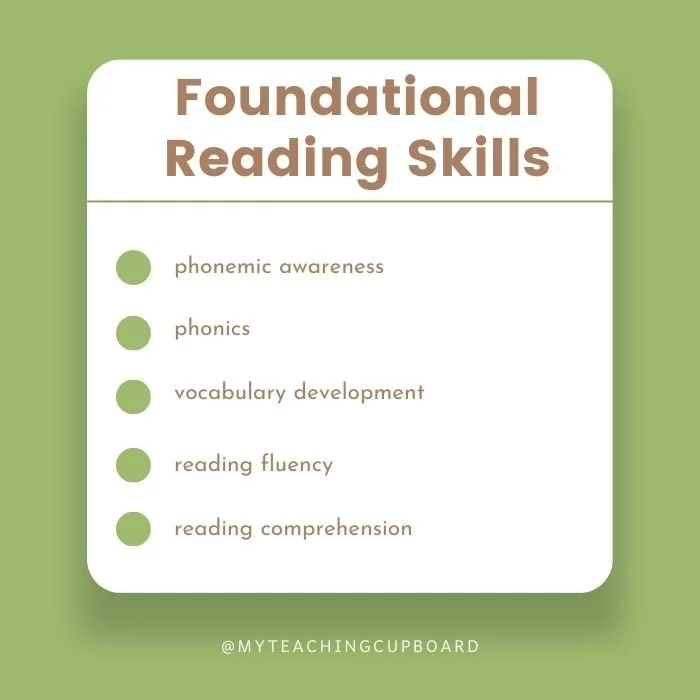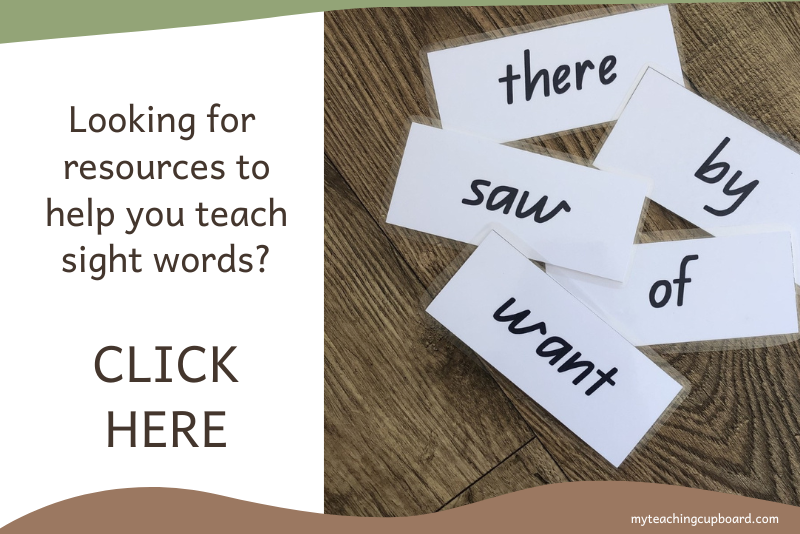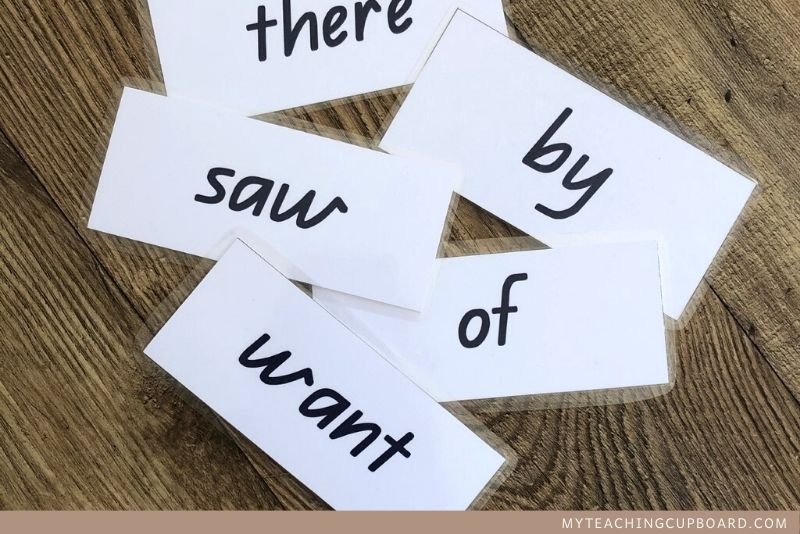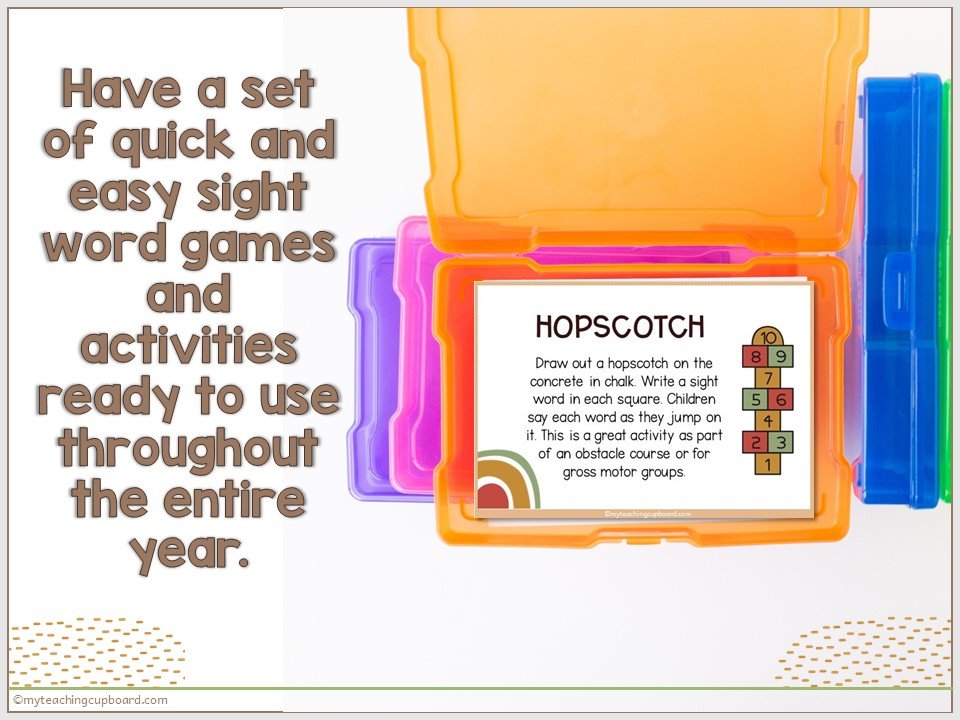Should We Teach the Kindergarten First 100 Sight Words?
Let's talk about something important – sight words! With the latest Science of Reading research in mind, should we even teach the First 100 Sight Words in kindergarten?
With the ever-evolving educational research and the Science of Reading gaining prominence, it's crucial we reevaluate our teaching practices and question the effectiveness of some of our old traditional approaches to teaching reading.
Sight words play an important role in early literacy, but recent research makes us question the effectiveness of traditional sight word teaching methods. In this post, we will look at the limitations of outdated sight word teaching practices and find out if teaching the First 100 Sight Words in kindergarten is truly beneficial or if there are alternative approaches that can better support early reading development.
Read on to discover some practical resources, research insights, and teaching examples that empower kindergarten teachers to rethink sight word instruction and create a strong foundation for lifelong reading success.
As a teacher, I believe in the power of teaching phonics to help children become independent readers. However, I've noticed that when my young students encounter tricky words like 'said,' 'was,' or 'saw,' they struggle. Their reading confidence takes a hit too.
We are using the PM Reading scheme at our school, and it certainly doesn’t support a pedagogy based on decoding and phonics. Irregular words show up quite often in the PM reading series, and they can sometimes cause frustration and worry for my students who are still learning how to decode.
But I’ve found a way to ensure my students still learn those important decoding skills and can also tackle the PM reading books with confidence and success. Yes, I’m still teaching sight words. I might not be teaching them like I used to in the olden days, though! I've discovered a better system. These high-frequency words need to be taught, and they need to be learned so well that they become automatic.
What are Kindergarten Sight Words?
Some people call sight words high-frequency words, but I think they are different types of words. Both sight words and high frequency words are the most common words that appear frequently in written text. These words often do not follow regular phonetic patterns, making them difficult to decode using basic phonics rules.
What is the difference between sight words and high frequency words?
The terms sight words and high-frequency words are often used interchangeably, but I think they can have slightly different meanings depending on the context. Here's a breakdown of the differences:
Sight Words: Sight words are words that readers are encouraged to recognise instantly, by sight. These words often do not follow regular phonetic patterns and cannot be easily decoded using basic phonics rules. In the past, sight words were typically taught through memorisation and visual recognition. They are considered important because they appear frequently in written texts, and their automatic recognition is considered critical for developing reading fluency and comprehension.
High-Frequency Words: High-frequency words, on the other hand, refer to words that appear frequently in written text, regardless of their phonetic regularity. These words include both common sight words as well as other words. While some high-frequency words can be decoded using basic phonics skills, others require more advanced decoding skills requiring readers to use knowledge of digraphs and irregular spelling patterns.
High-frequency words are important for readers to recognise and understand, as they make up a significant portion of written material and contribute to overall reading proficiency.
In the past, teachers taught sight words to their students so that they could be recognised and read instantly by sight. That’s how they got the name sight words.
Over the years, many sight word lists have been developed for different grade levels and reading programs. Teachers would introduce sight words gradually, starting with a small set of 10 or 20 and gradually adding more as students progressed. Various techniques and activities were used in the classroom and set as homework to help students learn and reinforce sight word recognition.
It's important to note that these are seen as outdated practices now. With the highlight on the Science of Reading Research, educators have found that they need to approach the teaching of sight words in a different way. Some educators say they don’t even teach them anymore.
As our understanding of literacy instruction evolves, educators and researchers have identified effective strategies for teaching sight words. Recent studies have shed light on the most efficient and evidence-based approaches to sight word instruction. In the following section, we will explore some of the latest research findings and recommended practices for teaching sight words based on the Science of Reading.
The Science of Reading Research on Teaching Sight Words
The Science of Reading is a body of research that helps us understand how children learn to read. It draws upon extensive research from various disciplines like cognitive psychology, linguistics, neuroscience, and education.
As far as kindergarten teachers are concerned, this research can tell us what the best evidence-based approaches to teaching reading are and help us to identify the most effective instructional methods for ensuring reading success in our little ones.
The Science of Reading research emphasises the importance of systematically teaching foundational reading skills like:
phonemic awareness (the ability to recognise and manipulate individual sounds in words)
phonics (the relationship between letters and sounds)
vocabulary development
reading fluency
reading comprehension
Research in the science of reading has debunked some traditional assumptions about reading instruction and highlighted the critical role of explicit and systematic phonics instruction. It emphasises the need for direct teaching of phonics skills, decoding strategies, high frequency word recognition, and the integration of these skills with reading comprehension strategies.
To delve deeper into the Science of Reading and the significance of phonics instruction and word decoding skills, I recommend checking out this informative blog post: Science of Reading Decoding Strategies with CVC Words.
The post provides valuable insights into the principles of the Science of Reading and offers practical strategies for teaching students to decode CVC (consonant-vowel-consonant) words. You’ll get a deeper understanding of the Science of Reading and its implications for effective reading instruction by reading: Science of Reading Decoding Strategies with CVC Words
By applying the principles and findings of the science of reading, educators can make informed decisions about instructional practices and help their students become proficient readers.
We all know that phonological awareness, phonemic awareness, and phonics should be explicitly taught in kindergarten. The focus of reading instruction in kindergarten is teaching children to accurately sound out printed words. The active sounding out of words using letter-sounds knowledge is referred to as reading through the phonological pathway in the Science of Reading research.
The research has found that children learning to read rely on the phonological pathway to decode and read words. Repeated decoding of any individual word over time causes that word to become retained in a child’s long-term memory through a process known as orthographic mapping.
This allows the reader to recognise the word automatically and read the word without needing to actively sound it out every time.
Automatic recognition of words is called the lexical pathway for reading. It takes a lot of deliberate practice for kindergarteners to build up enough words in their mental word banks to read texts with any fluency.
Skilled readers will mainly use the lexical pathway, but they still use the phonological pathway if they come across an unfamiliar word.
If you have children that seem to instantly recognise a word, they have learned to decode that word quickly using the phonetic patterns stored in their memory. It’s like they have created a mental phonetic word bank.
So, when children come across these high frequency words while reading, they seem to be instantly recognising them without having to sound them out. But don’t be fooled! They are still decoding. They are very proficiently decoding and have learned to decode that word so well that it is recognised instantly – by sight.
Research tells us that this recognition is where comprehension truly begins. The more words a child has in their mental word bank, the better they can understand what they're reading.
According to the helpful Research into Practice series by the DECS Literacy Secretariat, explicit and systematic teaching of sight words is recommended. Instead of trying to teach these words as they come up in a story, it's actually easier for most children to learn them separately at first. However, it's important to note that recognising words in isolation doesn't guarantee quick or instant recognition when they appear in a text.
That's why it's crucial to provide children with regular and repeated practice of their newly learned high frequency words in meaningful contexts. Once these words have been explicitly taught, they need to be reinforced and practiced immediately and often within texts.
It is so important for fluency and comprehension that common letter combinations and sight words are not only learned but that they are learned so well that they are recognised instantly – by sight.
The goal of teaching letter-sound knowledge – both phonics and sight words – to the point of automaticity is rapid word recognition. It is of great importance for fluency and understanding that common letter combinations and sight words are not only learned, but that they are learned so well that they are recognised immediately. When an unknown word appears in text, children will feel more confident if parts of that word are immediately recognised. This greatly increases the likelihood that the whole words will be successfully decoded, and eventually that the whole words are recognised on sight. Reading comprehension starts with the immediate and accurate recognition of words as this allows the reader to concentrate on the meaning of the text rather than on decoding.
From Understanding the Reading Process
You will improve reading comprehension when your students learn to read sight words fluently. Reading comprehension starts with the immediate and accurate recognition of words because this allows the child to concentrate on the meaning of the text rather than on the decoding.
However, if you rely solely on "whole language" or a pedagogy that uses cueing methods when teaching early reading, your students may not develop the automaticity needed to step beyond reading words to develop that comprehension.
You are probably familiar with many different sight word lists. There are commonly available lists like the Dolch 220 list or the Fry Word List, and I’ve even compiled my own list to correlate with the PM reading series. However, sight words are much more than the high-frequency words that appear on these lists.
The Science of Reading suggests that learning to decode these commonly occurring irregular words through a phonetic approach is more effective than rote memorisation. It states that when a student decodes a word several times, that word can anchor successfully in their sight word memory.
What do you think?
Teaching a small list of high-frequency words through what we call sight word games and other hands-on activities has certainly helped my beginning readers. We learn the associated tricky letter combinations in Prep, but most are left for grade one. We primarily focus on single letter sounds and CVC words in Prep or Foundation Stage.
In kindergarten, some high-frequency words can be decoded using basic phonics skills, but there are others that require more advanced decoding skills using digraphs and irregular spelling patterns. If you want your students to move beyond simple decodable readers or if your students are like mine and need to read the PM readers or even picture books from the library, you need to be teaching those more advanced decoding skills using digraphs and irregular spelling patterns.
And there’s HEAPS of them! There are 44 phonemes (speech sounds) and hundreds of spelling patterns that can be used to represent those phonemes. It’s impossible to teach all of them in kindergarten.
So how do you know which spelling alternatives you should teach in kindergarten?
That’s when I turn to the old traditional Dolch Sight Word List and the Fry Lists of sight words to find out the Kindergarten First 100 Sight Words I need to teach.
Dolch Sight Word List
The Dolch Sight Words list is the most commonly used set of sight words, and it is the one I use. It was developed by Dr. Edward William Dolch in the 1930s-40s. He studied the most frequently occurring words in children’s books of that era and compiled a list of 220 service words and 95 high-frequency nouns.
These words comprise 80% of the words you would find in a typical children’s book and 50% of the words found in writing for adults. Once a child can decode these words quickly and automatically, it improves their reading fluency and allows them to focus on comprehension.
The Dolch words are commonly divided into groups by grade level. They are set out in lists ranging from pre-kindergarten to third grade. There’s a separate list of nouns. All in all, there are a total of 315 Dolch Sight Words.
Here’s a list of the 40 Pre-K Dolch Sight Words
a, and, away, big, blue, can, come, down, find, for, funny, go, help, here, I, in, is, it, jump, little, look, make, me, my, not, one, play, red, run, said, see, the, three, to, two, up, we, where, yellow, you
This is the list of the 52 Kindergarten Dolch Sight Words
all, am, are, at, ate, be, black, brown, but, came, did, do, eat, four, get, good, have, he, into, like, must, new, no, now, on, our, out, please, pretty, ran, ride, saw, say, she, so, soon, that, there, they, this, too, under, want, was, well, went, what, white, who, will, with, yes
You can download the full list HERE: Dolch Sight Word List .pdf
Fry List
The Fry Sight Words list is an extensive collection of words more recent than the Dolch list. It was developed by Dr. Edward Fry in the 1950s, with an update in 1980. The list includes the most common 1,000 words found in reading materials used in Grades 3-9. Mastering all of the 1,000 Fry words would enable a child to read approximately 90% of the words in a typical book or website.
The Fry words are organised according to their frequency of occurrence and are often divided into groups of 100. For instance, the first 100 Fry words represent the most frequently used words in the English language. These words are considered high-frequency words, accounting for up to 90% of the words found in children's reading materials.
The first 25 words in Fry’s list make up around 30% of the words encountered in children's materials, while the top 100 words account for half of the words.
Here’s the list of the First 100 Fry Sight Words in order of frequency:
The, of, and, a, to, in, is, you, that, it, he, was, for, on, are, as, with, his, they, I, at, be, this, have, from, or, one, had, by, words, but, not, what, all, were, we, when, your, can, said, there, use, an, each, which, she, do, how, their, if, will, up, other, about, out, many, then, them, these, so, some, her, would, make, like, him, into, time, has, look, two, more, write, go, see, number, no, way, could, people, my, than, first, water, been, called, who, oil, sit, now, find, long, down, day, did, get, come, made, may, part
You can download the full list HERE: Fry Sight Word List .pdf
Understanding the spelling patterns used in the Dolch and Fry sight words is crucial for effective decoding instruction. Since many of the Dolch and Fry words cannot be easily decoded phonetically, we need to carefully look at the spelling patterns used in these words so that we can teach these tricky decoding patterns to our beginning readers.
When our kindergarteners become proficient at decoding the first 100 words from either the Fry or Dolch list, they will be able to read a significant portion of their kindergarten texts independently. Not only that, but their reading confidence receives a remarkable boost as well.
To support you in teaching these decoding skills and spelling patterns to your kindergarten students, I’ve already studied these sight word lists and compiled a list of all the alternative spelling patterns you’ll need to teach your kindergarten students. You can download it from my free resources library HERE.
Within this list, you'll find the complete Dolch and Fry Sight Word Lists, along with the corresponding alternative spelling patterns. Equipped with this resource, you'll be well-prepared to guide your students toward fluent reading of these high-frequency words.
Looking for fun activities to teach sight words?
If you are a teacher looking for a fun and effective way to teach sight words, you will want to purchase my 47 Sight Word Games and Activities.
We know that learning sight words is a crucial step in developing reading fluency and comprehension, and my engaging sight word games and activities are designed to make this process enjoyable and memorable for your students. With 47 hands-on exercises, there are heaps of options to keep your students excited and motivated to learn their sight words.
Aligned with the Science of Reading
Backed by the latest research from the Science of Reading, my sight word games and activities are meticulously crafted to promote sight word recognition and fluency in kindergarten students. I understand the importance of mastering common letter combinations and high-frequency words. That's why my sight word resources ensure that these words are not just learned, but recognized instantly—by sight!
Save Time and Maximise Learning
As a teacher, believe me – I know that your time is valuable. That's why I designed them so they are ready to use and require minimal prep work for you.
Versatile and Easy to Use
My sight word games and activities can be used digitally or printed onto A4-sized cards or paper. Simply cut and store them on a binder ring or in a task card box, and you'll have a set of quick and easy sight word games and activities ready to use throughout the entire year. No more struggling to find resources or spending endless hours planning lessons—this comprehensive set has you covered!
Conclusion
In conclusion, the teaching of sight words in kindergarten is still important and deserves a place in our early reading instruction. While the Science of Reading research emphasises the need for systematic phonics instruction and decoding skills, sight words still play a crucial role in developing reading fluency and comprehension.
High-frequency words, often called sight words, are words that appear frequently in written text and often do not follow regular phonetic patterns. They cannot be easily decoded using basic phonics rules, and that makes them challenging for young readers.
However, through explicit and systematic teaching, students can learn these words to the point of automaticity, and that’s going to mean better reading fluency and improved comprehension.
The Science of Reading research highlights the significance of teaching foundational reading skills, including phonemic awareness, phonics, vocabulary development, reading fluency, and reading comprehension. It debunks traditional assumptions about reading instruction and emphasises the need for direct teaching of phonics skills, decoding strategies, and high-frequency word recognition.
We no longer teach sight words in the traditional sense of memorisation and visual recognition because the research suggests that a phonetic approach to decoding these irregular words is much more effective. By decoding sight words repeatedly, students can anchor them successfully in their lexical pathway, leading to immediate recognition when encountered in text.
It is important to note that sight word instruction should be combined with regular and repeated practice in meaningful contexts to reinforce learning and promote fluency and comprehension. Teaching advanced decoding skills, such as digraphs and irregular spelling patterns, is crucial for students to move beyond simple decodable readers and tackle more complex texts.
Both the Dolch and Fry Sight Word Lists provide valuable resources for identifying the most common high-frequency words and the corresponding spelling patterns. By understanding these patterns, educators can effectively teach decoding skills and support their students in reading a significant portion of kindergarten texts independently.
Incorporating the principles and findings of the Science of Reading into instructional practices enables educators to make informed decisions and help students become proficient readers. By teaching phonics skills and decoding strategies alongside sight words, your students will develop the automaticity needed for comprehension and can focus on the meaning of the text rather than decoding.
Sight word instruction, when approached systematically and in conjunction with phonics skills, contributes to the development of reading fluency, comprehension, and overall reading proficiency in kindergarten and beyond.
If you found this blog post on teaching the Kindergarten First 100 Sight Words useful, others might too. Please consider sharing it…
Just CLICK the sharing box below.👇












